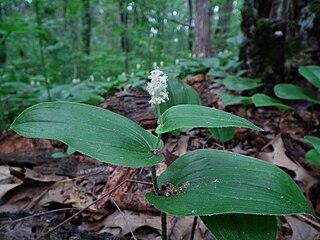
Maianthemum canadense is an understory perennial flowering plant, native to Canada and the northeastern United States, from Yukon and British Columbia east to Newfoundland, into St. Pierre and Miquelon. It can be found growing in both coniferous and deciduous forests. The plant appears in two forms, either as a single leaf rising from the ground with no fruiting structures or as a flowering/fruiting stem with 2-3 leaves. Flowering shoots have clusters of 12–25 starry-shaped, white flowers held above the leaves.
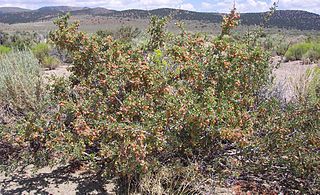
Prunus andersonii is a species of shrub in the rose family, part of the same genus as the peach, cherry, and almond. Its common names include desert peach and desert almond. It is native to eastern California and western Nevada, where it grows in forests and scrub in desert and mountains. It was named after Charles Lewis Anderson by Asa Gray.

Paeonia brownii is a low to medium height, herbaceous perennial flowering plant in the family Paeoniaceae. It has compound, steely-gray, somewhat fleshy leaves and small drooping maroon flowers. Its vernacular name is Brown's peony, native peony or western peony. It is native to the western United States and usually grows at altitude, often as undergrowth in part-shade. The fleshy roots store food to carry the plant through the dry summers and produce new leaves and flowers the following spring.
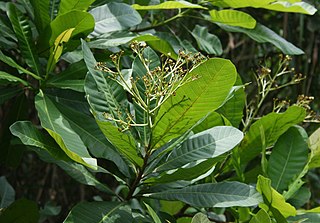
Anacardium excelsum, the wild cashew or espavé, is a tree in the flowering plant family Anacardiaceae. The tree is common in the tropical and subtropical dry broadleaf forests of Pacific and Atlantic watersheds of Central and South America, extending as far north as Guatemala and south into Ecuador.

Lonicera involucrata, the bearberry honeysuckle, bracted honeysuckle, twinberry honeysuckle, Californian Honeysuckle, twin-berry, or black twinberry, is a species of honeysuckle native to northern and western North America.

Erythronium revolutum is a species of flowering plant in the family Liliaceae which is known by several common names, including mahogany fawn lily, coast fawn lily, and pink fawn lily. It is native to the west coast of North America.

Fritillaria pluriflora is a rare California fritillary known as adobe lily. This wildflower is mainly limited to northern California. It grows in adobe clay soils of the Coast Ranges and low hills in the Central Valley from Tehama and Mendocino Counties south to Solano County.

Gaultheria ovatifolia is a species of shrub in the heath family which is known by the common names western teaberry, Oregon spicy wintergreen, and slender wintergreen. It is native to western North America from British Columbia to California, where it grows in high mountain forests.
Allium bolanderi is a species of wild onion known by the common name Bolander's onion. It is native to northern California and southwestern Oregon, where it grows in the rocky soils of the Klamath Mountains and surrounding regions.

Antennaria racemosa is a species of flowering plant in the family Asteraceae known by the common name racemose pussytoes. It is native to western North America from British Columbia and Alberta south as far as northern California and Wyoming. It grows in mountain forests, generally in moist, partially shaded areas, and often colonizes bare patches of mineral-rich soil, including disturbed areas.

Prosartes hookeri is a North American species of flowering plants in the lily family known by the common names drops of gold and Hooker's fairy bells.

Lilium rubescens is an uncommon species of lily known by the common names redwood lily and chaparral lily. It is native to northwestern California and southwestern Oregon, where it is known from the Coast Ranges from Lane County to Santa Cruz Counties.

Pyrrocoma carthamoides is a species of flowering plant in the family Asteraceae known by the common name largeflower goldenweed. It is native to western North America from British Columbia to northeastern California to Wyoming, where it is known from grassland, woodlands, forests, barren areas, and other habitat. It is a perennial herb growing from a taproot and producing one or more stems to about half a meter in maximum length, the stems reddish-green and leafy. The largest leaves are at the base of the stem, measuring up to 20 centimeters long, lance-shaped with spiny sawtoothed edges. Leaves higher on the stem are smaller and hairier. The inflorescence is a single flower head or a cluster of up to four. Each bell-shaped head is lined with phyllaries each up to 2 centimeters long. It has many yellow disc florets surrounded by a fringe of yellow ray florets up to 7 millimeters long; ray florets are occasionally absent. The fruit is an achene which may be well over a centimeter in length including its pappus.
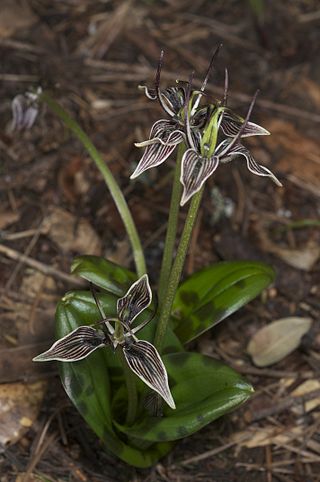
Scoliopus bigelovii is a species of flowering plant in the lily family known by several common names, including California fetid adderstongue, Bigelow's adderstongue, slinkpod, and brownies. It is native to California, where it is known from the Santa Cruz Mountains, parts of the San Francisco Bay Area and North Coast Ranges. It has also been collected just over the border in Oregon. It occurs in old-growth forest in the understory of redwoods. It grows in mossy, moist places, often in shade.
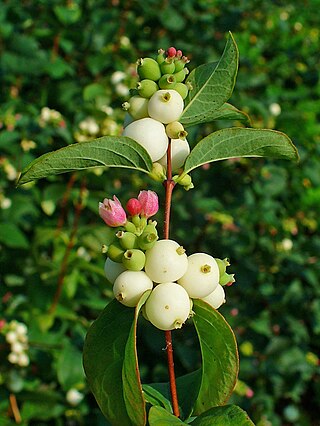
Symphoricarpos albus is a species of flowering plant in the honeysuckle family known by the common name common snowberry. Native to North America, it is browsed by some animals and planted for ornamental and ecological purposes, but is poisonous to humans.

Prosartes, the fairybells, is a North American genus of flowering plants in the lily family.

Triteleia grandiflora is a species of flowering plant known by the common names largeflower triteleia, largeflower tripletlily, and wild hyacinth.
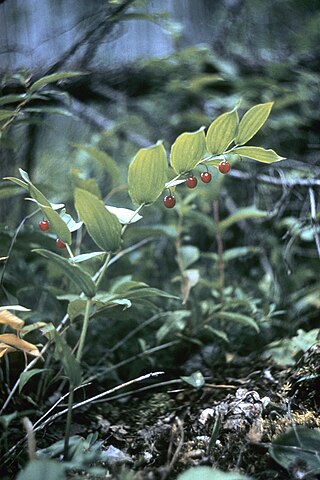
Streptopus lanceolatus, is an understory perennial plant native to the forests of North America, from Alaska to Labrador, south through the Great Lakes and Appalachian Mountain regions of the United States, as well as Montana, Washington state, Oregon, and St. Pierre & Miquelon. It grows primarily in mixed-wood forests, and throughout a wide range of soil and site conditions, preferring cool, acidic soils.

Prosartes maculata is a North American species of plants in the lily family with the common names yellow mandarin, spotted mandarin, or nodding mandarin. It is a perennial plant that flowers in the spring.

Arctostaphylos hooveri, the Santa Lucia manzanita, is a plant species endemic to the Santa Lucia Mountains in Monterey County, California. It grows in woodlands and in chaparral scrub-land at elevations of 900–1200 m.




















